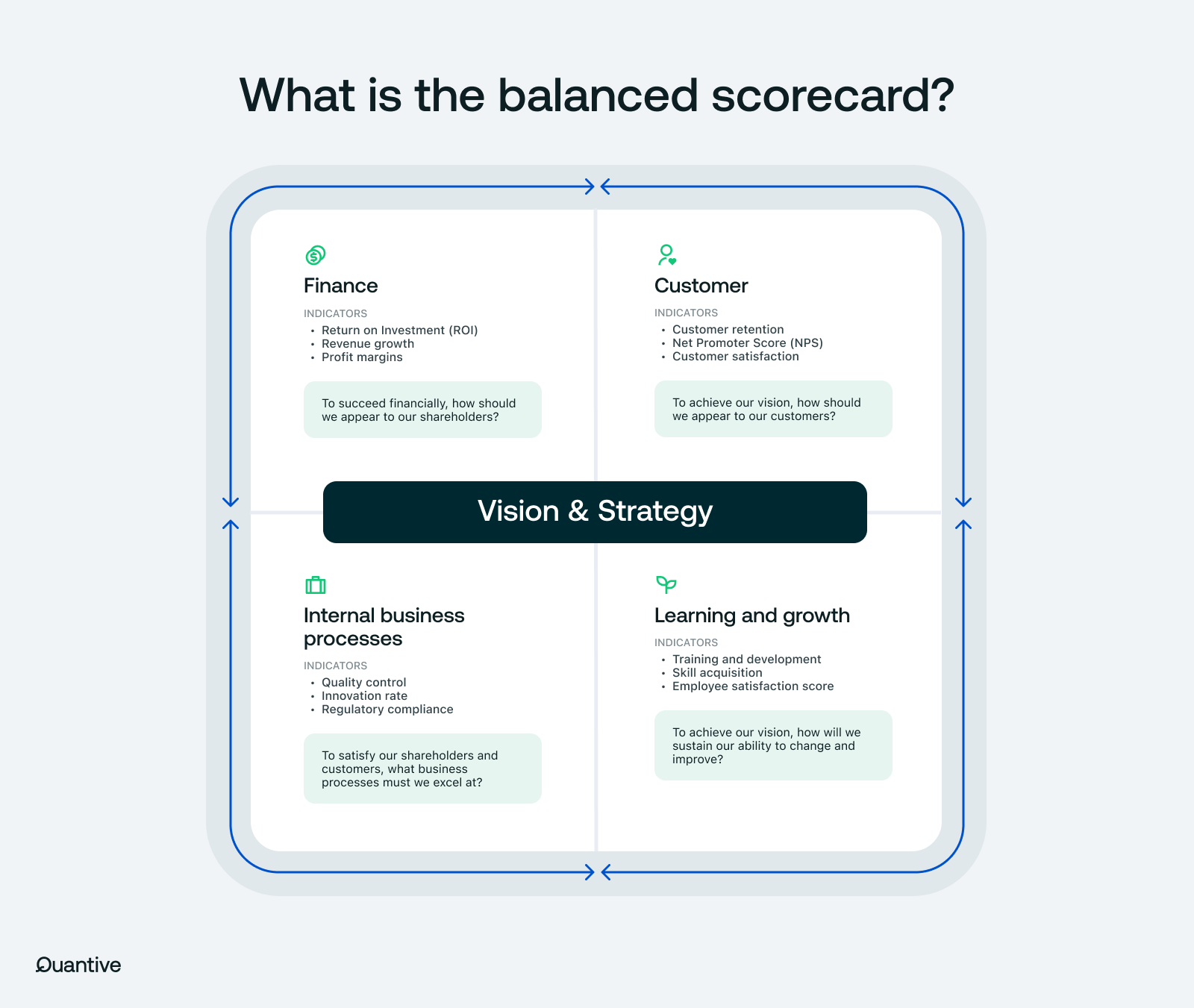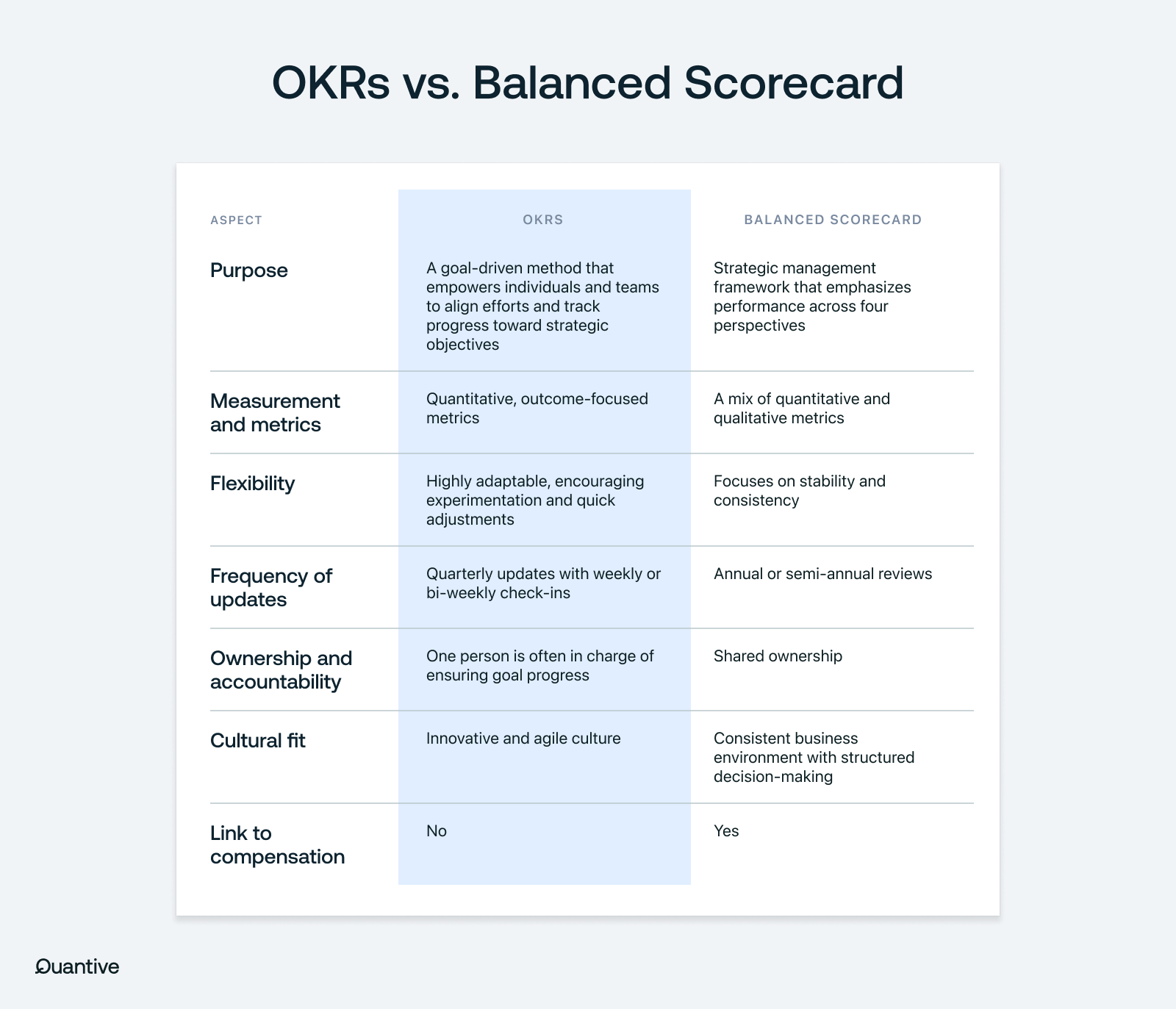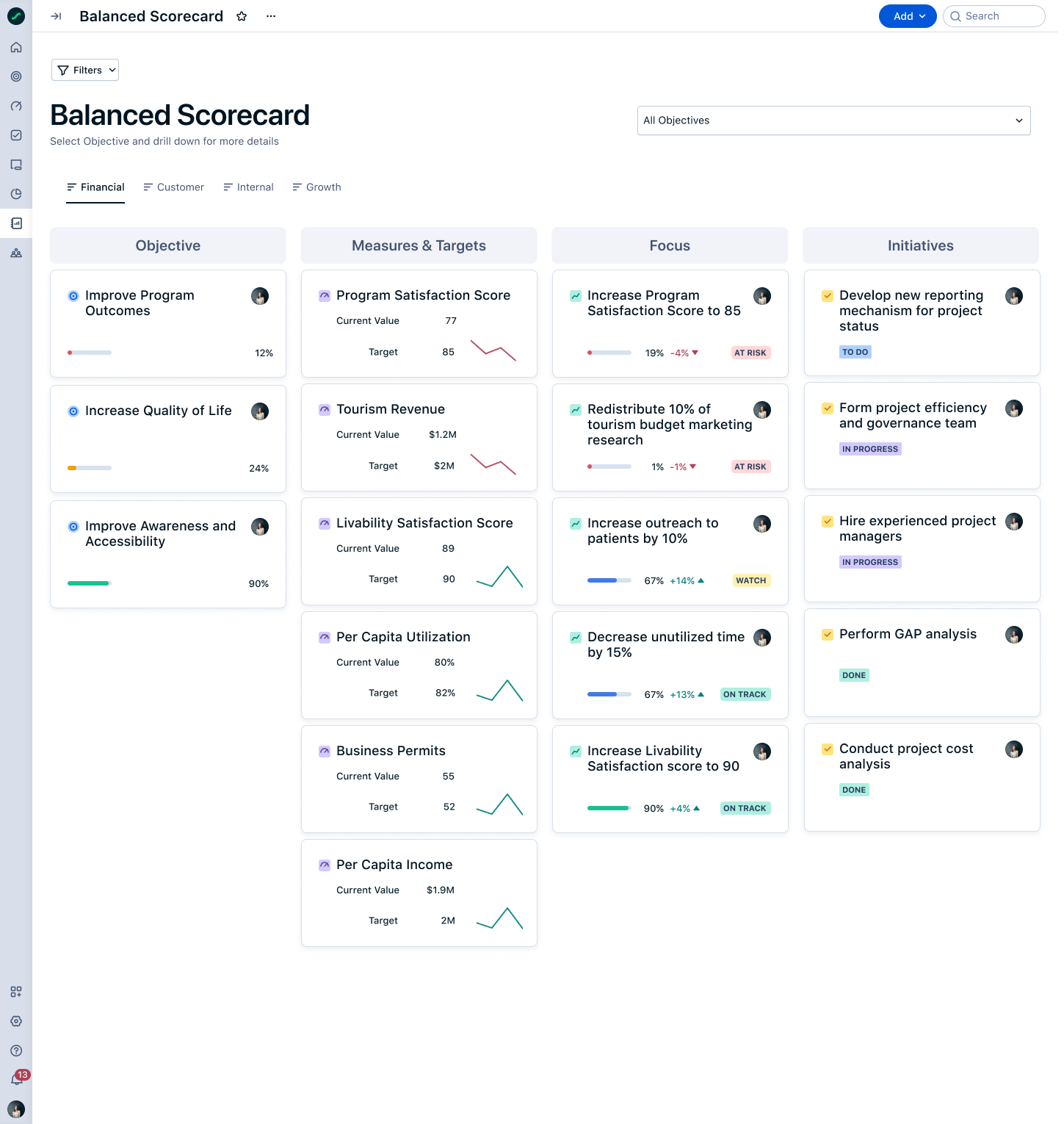Your business strategy is the roadmap guiding you toward desired outcomes. However, it’s the milestones and goals you achieve along the way that keep you on the right path. Staying on the right track involves informed decision-making, adaptability, and refining your strategy and execution plans to achieve these goals on an ongoing basis.
Objectives and key results (OKRs) and the balanced scorecard (BSC) are powerful strategic frameworks that can help you set, track, and execute your goals. Yet, given their distinct approaches, choosing between OKR vs. balanced scorecard requires a careful analysis of their capabilities of what they can do for your business.
To help you make the right choice, this article will:
- Define OKRs and balanced scorecard
- Break down the differences between OKR vs. BSC
- Highlight their similarities
- Cover use cases for OKR vs. balanced scorecard
- Explore the potential of OKR and the balanced scorecard combined
- Break down how you can use OKRs and BSC together
What are objectives and key results?
OKRs are a collaborative goal-setting methodology businesses, teams, and individuals can use to establish aspirational yet realistic goals with measurable outcomes. They facilitate goal attainment using their two components:
- Objectives: Clear, qualitative, and motivational descriptions of what you want to achieve
- Key results: Specific, time-bound, and measurable metrics that measure progress toward an objective, with each objective typically being supported by two to four key results
Want to go beyond the basics? Get an in-depth look at OKRs

What is the balanced scorecard?
BSC is a strategic management framework and performance measurement system that evaluates performance across four perspectives:
- Financial: Focuses on profitability, shareholder perception, and financial objectives like return on investment (ROI), revenue growth, and profit margins
- Customer: Addresses how customers perceive the company using measures like customer retention, net promoter score (NPS), and customer satisfaction
- Internal business processes: Looks at how efficiently and effectively the company functions, evaluating aspects such as quality control, innovation rate, and regulatory compliance
- Learning and growth: Examines how well a company uses intangible assets, such as training and development, skill acquisition, and employee satisfaction score

The balanced scorecard framework encourages organizations to set objectives, establish metrics, and analyze data across these perspectives, ensuring they align with each other and the overarching business strategy. These are achieved using:
- Objectives: Strategic goals that an organization aims to accomplish across the four key perspectives. These provide a clear direction for the organization's strategic focus.
- Measures (or KPIs): Specific, quantifiable metrics associated with each objective. These quantify, track, and assess an organization's progress in meeting its strategic objectives.
- Initiatives: Concrete actions undertaken to drive performance improvements, align operations with strategic objectives, and achieve desired outcomes.
OKR vs. BSC: Differences and similarities
Now that we’ve covered the basics, let’s compare OKR vs. balanced scorecard, examining the two frameworks’ differences and similarities.
Differences
Purpose
- OKRs take a goal-centric approach focused on specific objectives and measurable key results
- BSC provides an overview of organizational performance across multiple perspectives
Measurement and metrics
- OKRs emphasize quantitative, outcome-focused metrics
- BSC combines quantitative and qualitative metrics, using both leading and lagging indicators
Flexibility
- OKRs adapt to changing market conditions and priorities, encouraging ambitious goals that require innovation, experimentation, and iteration
- BSC focuses on stability and consistency
Frequency of updates
- OKRs are reviewed quarterly, including weekly or biweekly OKR check-ins, for shorter planning cycles
- BSC is typically reviewed annually or semi-annually, involving extensive planning and reporting for longer-term plans
Ownership and accountability
- OKRs can involve multiple contributors, but one person is typically accountable for the progress of a particular objective or key result
- BSC may involve numerous stakeholders and shared ownership
Cultural fit
- OKRs suit innovative, agile cultures
- BSC aligns with structured decision-making and non-disruptive business environments
Link to compensation
- OKRs are usually not linked to compensation
- BSC has a more direct connection to compensation

Similarities
Both OKRs and BSC....
- Ensure alignment with strategic goals by promoting a shared, joint vision throughout the organization
- Emphasize performance metrics by tracking and measuring progress
- Cascade priorities, with OKRs breaking down high-level goals into lower-level ones and BSC funnelling strategic objectives down to operational ones
- Encourage communication and transparency to promote a culture of openness, collaboration, and accountability
- Drive continuous improvement by uncovering areas that need corrective action
- Share principles with the management by objectives (MBO) approach, including goal setting and performance measurement
BSC vs. OKR: Advantages and disadvantages
Knowing what these frameworks can’t do is as important as knowing what they can do. Below, we highlight the strengths and weaknesses of BSC vs. OKR to help you assess their suitability for your business.
Balanced scorecard
Advantages
- Offers a comprehensive view of organizational performance
- Encourages long-term strategic focus
- Balances both leading and lagging indicators, covering quantitative and qualitative metrics
Disadvantages
- Can be complex to implement and maintain, requiring significant data collection, analysis, and reporting
- Risk of overloading with too many metrics
- May hinder adaptability
Objectives and key results
Advantages
- Simple and accessible
- Boosts employee engagement
- Well-suited for dynamic environments
- Encourages rapid learning and development
- Focuses on outcomes over processes
Find out more about the benefits of using OKRs here.
Disadvantages
- May lead to a focus on short-term results at the expense of long-term strategy if there is no long-term "North Star" company OKR
- Can become unrealistic if not managed properly, leading to frustration
- May cause resistance to change

When to use OKR vs. balanced scorecard
Choosing between OKRs and BSC depends on your organization’s characteristics, environment, and goals.
OKRs are ideal for fast-paced businesses or agile environments that demand quick decision-making and frequent strategic adjustments. They empower you to adapt, seize new opportunities, and tackle emerging challenges using a can-do attitude to drive continuous improvement and stretch the boundaries of success.
On the other hand, BSC is suitable for mature organizations with well-established, long-term strategies that operate in industries where tight regulations and strict procedures require process stability.
Can you use OKR and the balanced scorecard combined?
It doesn’t have to be one framework or the other. Combining OKRs and BSC can be a powerful driver of success from multiple fronts, with their synergistic abilities creating many positive outcomes for your business.
By using OKRs and the balanced scorecard combined, you can:
- Sync short-term and long-term goals: Integrate your short-term OKRs with broader, long-term objectives outlined in the balanced scorecard to align day-to-day efforts with your big-picture strategy
- Achieve organizational alignment: Align OKRs with the perspectives of key stakeholders as defined in the BSC, ensuring employees work in the same direction to support your overall strategy
- Gain a holistic view of performance: Combine the data-driven insights from OKRs with qualitative insights from BSC to fuel data-driven decision-making
- Balance agility and stability: Stay adaptable to external changes while maintaining focus on long-term objectives
- Improve stakeholder communications: OKRs facilitate transparency during internal communications, while the balanced scorecard framework supports external reporting and compliance, enabling well-rounded stakeholder engagement
How to use OKRs and BSC together
Here’s a step-by-step approach to effectively combine BSC and OKRs into a united approach to strategic goal management:
- Define your strategy: Use the four perspectives of the balanced scorecard to shape your organization’s strategic direction
- Create high-level OKRs: Create OKRs for each BSC perspective, aligning them with your broader business strategy
- Map your OKRs: Lay out your OKRs on a strategy map for a visual representation of how your OKRs connect to the wider strategic goals developed using BSC
- Use supporting BSC metrics: Augment key results with leading and lagging indicators for a well-rounded approach to measuring progress
- Communicate these changes to all employees: Make sure employees understand how these integrated OKRs contribute to your company’s strategy, encouraging them to establish individual or team-level OKRs that align with it
- Track and review: Keep a close eye on your OKRs by conducting frequent OKR check-ins to encourage swift adjustments and maintain focus on strategic objectives
Streamline integration with OKR software
To make the integration of OKRs and BSC smoother, consider using OKR software as a unified platform for managing your performance indicators. OKR software:
- Facilitates multi-level OKR alignment: OKR software lets you create and visualize OKRs at different levels, from company-wide to team and individual levels, ensuring alignment with broader strategic objectives defined in BSC
- Integrates data sources: OKR software seamlessly integrates with your preferred applications and data sources, making it easy to embed OKRs throughout your organization and monitor progress effortlessly
- Streamlines OKR tracking: OKR software provides real-time performance dashboards, giving you a clear view of progress across your organization and sending alerts when OKRs are off track
- Generates reports: OKR software creates comprehensive reports on OKR performance, offering valuable insights for timely, data-driven decision-making
Using Quantive Results you can easily integrate the two frameworks to ensure a seamless flow of data toward your goals.
Here's what combining OKRs and BSC looks like using Quantive's OKR software:

Conclusion
While both OKRs and BSC can be valuable tools for shaping and executing your strategic path, choosing between OKRs and the balanced scorecard framework hinges on your organization’s needs. OKRs are particularly effective in dynamic, fast-paced environments, whereas the BSC shines in a well-established organization with long-term strategies and stable conditions.
Yet, the true power lies in combining the two approaches. Using OKRs and the balanced scorecard framework combined allows you to align short-term and long-term objectives, foster company alignment, get a comprehensive performance overview, and strike a balance between adaptability and stability. Using OKR software, you can further streamline the integration of the two frameworks, making it a seamless process for your business.
Quantive empowers modern organizations to turn their ambitions into reality through strategic agility. It's where strategy, teams, and data come together to drive effective decision-making, streamline execution, and maximize performance.
As your company navigates today’s competitive landscape, you need an Always-On Strategy to continuously bridge the gap between current and desired business outcomes. Quantive brings together the technology, expertise, and passion to transform your strategy from a static plan to a feedback-driven engine for growth.
Whether you’re a visionary start-up, a mid-market business looking to conquer, or a large enterprise facing disruption, Quantive keeps you ahead — every step of the way. For more information, visit www.quantive.com.

